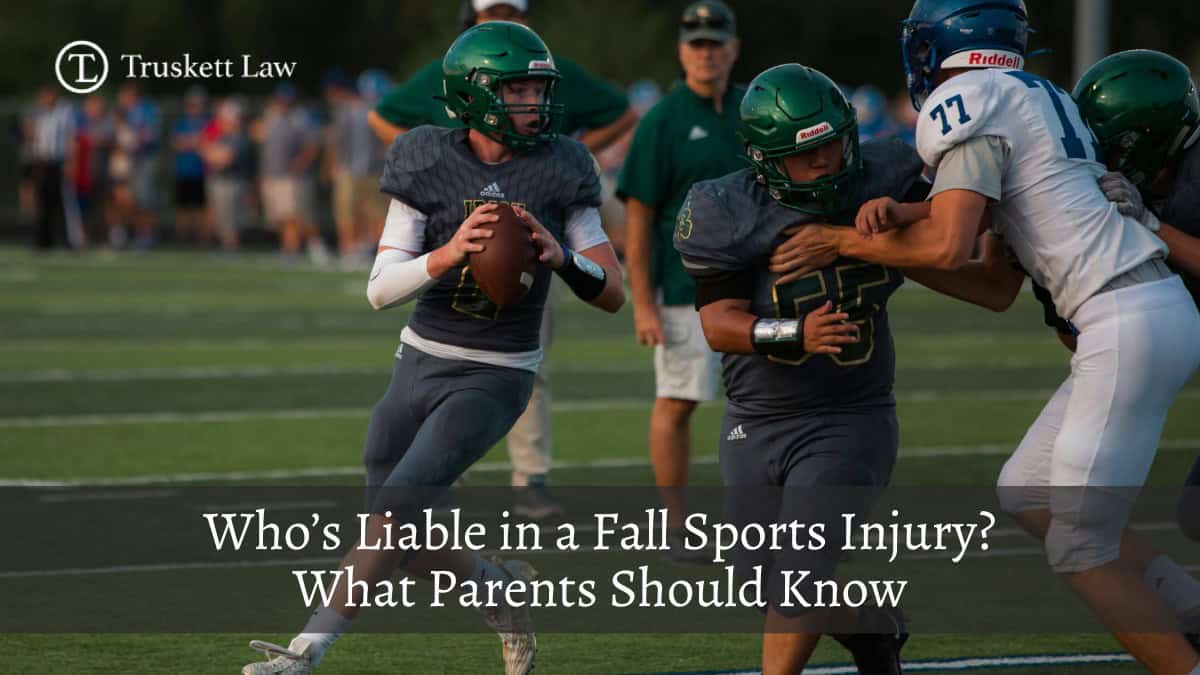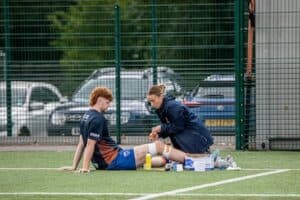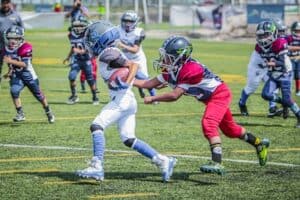
30 Sep Who’s Liable in a Fall Sports Injury? What Parents Should Know
As fall approaches, many families look forward to the excitement of school sports. Whether it’s football under the Friday night lights, soccer tournaments on crisp Saturday mornings, or cross-country meets, student athletes are gearing up for another competitive season. But with all the fun and teamwork that sports bring, injuries are unfortunately a common reality.
From sprains and concussions to more severe incidents like fractures or heat-related illnesses, parents are often left wondering: Who is responsible when a child is hurt playing sports? Understanding liability in fall sports injuries is essential for protecting your child’s health, your family’s financial well-being, and ensuring accountability where negligence is involved.
This guide will break down the legal aspects of sports-related injuries, explain where liability may lie, and help parents understand their rights if their child gets hurt.
The Reality of Fall Sports Injuries
Sports injuries are one of the leading causes of emergency room visits among children and teens. Football, soccer, cheerleading, and even cross-country running carry risks ranging from minor sprains to serious traumatic brain injuries.
While many injuries are accidental and part of the inherent risk of sports, others may be caused by negligence, unsafe facilities, or improper supervision.
The difference between an “accident” and negligence is what parents need to understand in order to determine if someone can be held legally liable.

Inherent Risks vs. Negligence
When a child signs up for a sport, parents typically acknowledge that there are “inherent risks” involved. These are injuries that naturally occur despite reasonable precautions—like a sprained ankle during a soccer match or a jammed finger while catching a football.
However, not all injuries fall under inherent risk. If an injury results from negligence—such as a coach failing to follow safety protocols, a school ignoring field maintenance, or improper medical response—it may be grounds for legal action.
Who Could Be Liable for a Sports Injury?
1. Schools and School Districts
Public schools have a duty to provide safe facilities, properly trained staff, and adequate medical resources for student athletes. If the school fails to maintain equipment, neglects to hire qualified coaches, or ignores safety concerns, they could be held liable.
2. Coaches and Athletic Staff
Coaches have a responsibility to train athletes safely and to follow concussion protocols, hydration breaks, and conditioning limits. If a coach pressures a student to play through an injury or fails to recognize signs of distress, liability may rest with them or the organization that employs them.
3. Sports Leagues and Clubs
Outside of school-sponsored activities, private leagues and sports clubs are also responsible for safety. Liability could arise if these organizations don’t provide appropriate supervision, use unsafe facilities, or ignore medical emergencies.
4. Equipment Manufacturers
If a piece of sports equipment—like a helmet, pads, or footwear—malfunctions or is poorly designed, the manufacturer may be held accountable under product liability law.
5. Property Owners
If the injury occurs on poorly maintained property, such as uneven turf, broken bleachers, or unlit parking lots, the property owner could also be responsible.
Common Scenarios Where Liability May Apply
- Concussions Ignored by Coaches: A coach who allows a child to continue playing after showing concussion symptoms may face liability.
- Unsafe Playing Fields: Schools or leagues that don’t maintain fields, leading to injuries from holes, uneven surfaces, or debris, can be responsible.
- Inadequate Supervision: If staff-to-player ratios are too low and an injury occurs due to lack of supervision, liability may apply.
- Defective Equipment: Helmets or pads that don’t provide adequate protection could shift liability to the manufacturer.
- Heat Exhaustion and Dehydration: If athletes aren’t provided with water breaks in hot conditions, negligence could be claimed.
The Role of Waivers in Sports Injuries
Most sports programs require parents to sign liability waivers before their children can participate. While these waivers acknowledge the inherent risks of sports, they don’t necessarily protect schools, leagues, or coaches from all claims.
If negligence is involved, waivers typically do not prevent parents from pursuing legal action. Courts often hold that you cannot waive away a child’s right to protection from gross negligence or recklessness.
What Parents Should Do After a Sports Injury
1. Seek Immediate Medical Attention
Always prioritize your child’s health. A thorough medical evaluation not only ensures proper treatment but also creates crucial documentation for any future claims.
2. Document the Incident
Take photos of the injury, the playing field, and any equipment involved. Collect witness statements from teammates, parents, or staff.
3. Report the Injury
Notify the coach, school, or league officials right away. A formal report helps establish a record of the incident.
4. Preserve Equipment
If defective gear caused the injury, don’t throw it away. Keep it as evidence.
5. Consult a Personal Injury Lawyer
Legal guidance can help you understand your options and determine whether negligence played a role in your child’s injury. An attorney can also explain how liability laws apply in your state and whether waivers or releases might affect your claim. With professional support, you’ll have a clearer path to pursuing justice and securing the compensation your child needs for recovery.

Compensation for Fall Sports Injuries
When liability is established, families may be entitled to compensation that covers:
- Medical expenses (hospital visits, surgeries, rehab, therapy)
- Future medical care for long-term injuries
- Lost income for parents who must miss work to care for their child
- Pain and suffering endured by the child
- Emotional distress and diminished quality of life
Preventing Sports Injuries: What Parents Can Do
While not all injuries are preventable, parents can take proactive steps to reduce risk:
- Ensure your child’s equipment fits properly and meets safety standards.
- Ask coaches about safety protocols, hydration policies, and emergency plans.
- Monitor your child for signs of fatigue, concussion, or dehydration.
- Encourage open communication—your child should feel comfortable reporting pain or discomfort.
Legal Complexities in Sports Injury Cases
Sports injury cases can be complicated, often involving multiple parties and complex liability laws. For example, determining whether a coach acted negligently or whether a waiver protects a school can require thorough legal analysis. Additionally, timelines for filing a claim (statutes of limitations) vary by state, so acting quickly is crucial.
These cases may also involve expert witnesses, such as medical professionals or athletic trainers, who can testify about proper standards of care. Insurance policies can overlap or conflict, making it challenging for families to understand who is ultimately responsible for paying damages. Because of these complexities, parents may find it overwhelming to pursue claims without skilled legal support.
When to Involve a Lawyer
If your child’s injury is serious, involves potential negligence, or results in long-term medical needs, consulting a personal injury lawyer is one of the most important steps you can take. An experienced lawyer can help investigate the incident, preserve evidence, and negotiate with schools, insurers, or organizations.
A lawyer can also determine whether waivers or releases are enforceable in your state and identify exceptions that may allow your case to move forward. They will ensure that all deadlines are met and that the claim is filed properly to protect your rights.
Most importantly, a lawyer can advocate for the full compensation your child deserves, rather than accepting a quick settlement that undervalues the long-term impact of the injury.
Protecting Your Child’s Rights After a Sports Injury with Truskett Law
At Truskett Law, we understand how devastating a sports injury can be for both the child and their family. Fall sports should be about teamwork, growth, and fun—not preventable harm caused by negligence. If your child has been injured in a school or league activity, our team can help you determine liability, gather evidence, and pursue the compensation your family deserves.
With compassionate guidance and experienced advocacy, we make sure your child’s rights are fully protected so you can focus on their recovery. Don’t wait to get answers and support—reach out to Truskett Law today to discuss your options and take the first step toward justice.


Sorry, the comment form is closed at this time.